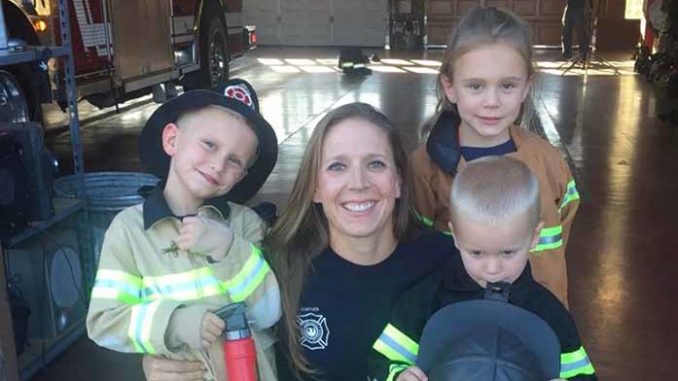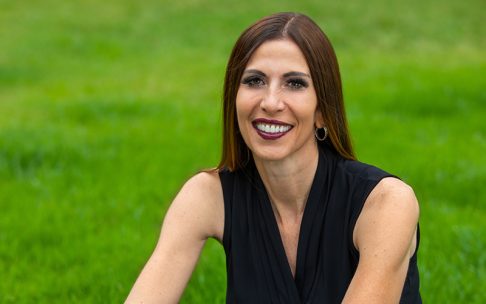
By Emma Ascott
PHOENIX – Nicole Minnick had been a firefighter for seven years when she gave birth in 2008 to her first child, a girl named Kyndal. A few months later, when she returned to work, one thought was foremost in her mind: Would it be safe to breastfeed?
“My second or third shift back to work, we had a fire – and my baby’s 3 months old. I was like, ‘Well I probably shouldn’t nurse her. How long do I need to pump and dump?’” Minnick recalled. “I called the fire department, and they had no idea.”
Turns out extensive research to determine how long carcinogens remain in the breast milk of female firefighters had never been conducted, prompting Minnick to take part in a University of Arizona study.
“This was my baby,” she said. “I wanted to know.”
Now a new UArizona study aims to build on that body of work and further understand the occupational risks unique to women in the fire service.
The three-year study, funded by a $1.5 million grant from the Federal Emergency Management Agency, will explore stress, cancer risks and the effect of toxins on reproductive health. Researchers hope to enlist 200 women – 100 incumbent firefighters and 100 new recruits – from departments across the U.S., including some from the Tucson Fire Department.
Comparing new recruits with those who’ve served for some years will help identify potential differences in stress and markers in blood associated with increased cancer risk.
“The women and men of the fire service are keeping those of us in the public safe, and therefore it’s really important that we help them by providing information that they can use to keep themselves safe,” said Dr. Jeff Burgess, associate dean for research at UArizona’s College of Public Health.
The project includes a “virtual kitchen table” to provide mentorship for female firefighters with a goal of building resilience and reducing stress. The idea, researcher Sara Jahnke said, is to form an official research question around “What do you need to be supported?”
“What we know from the research that we’ve done in general in the fire service, and specifically with men in the fire service, is that so much of ‘What is resilience-building in the fire service?’ is what happens around that kitchen table,” said Jahnke, director of the Center for Fire, Rescue & EMS Health Research at the nonprofit National Development Research Institutes. “So it’s the bonding that takes place, it’s the decompressing, it’s the joking around.”
Little is known about the health of female firefighters because they are in the minority. The National Fire Protection Association estimates just 4% of career firefighters in the U.S. and 11% of volunteer firefighters are women, or about 15,000 and 78,000 respectively.
Minnick, a captain medic for the Phoenix Fire Department, said fewer than 80 of the 1,500 to 1,600 firefighters in the department are women, including the chief.
The toxicity that harms firefighters may contribute not just to cancer but to reproductive problems in women in the service. Not only do burning materials release chemicals, but some of the foams that firefighters use to put out fires contain chemicals that can be potentially damaging.
Previous research suggests that female firefighters may be at increased risk of miscarriage and preterm birth compared with the general population, according to Leslie Farland, a UArizona assistant professor who will focus on reproductive health as part of the study.
She will examine levels of AMH, or anti-Mullerian hormone, which helps determine the number and quality of a woman’s ovarian reserve, or egg supply.
The hormone is “also associated with risk of other adverse reproductive outcomes, like miscarriage and other things,” Farland said. “We’re interested in understanding whether or not women firefighters have either lower levels of AMH, indicating that they have a lower ovarian reserve, and/or whether or not their AMH levels change over time.”
The study also will measure biomarkers of cancer risk and include a detailed questionnaire about stress levels, reproductive history, menstrual cycle and cancer risk factors. Farland said researchers will watch to see whether those self-reported variables change over time.
Burgess also is working to wrap up the study Minnick participated in, examining toxins found in the breast milk of female firefighters.
By collecting breast milk from women after they fought fires, “We can actually measure chemicals from the fire, which peak after the fire and then they go back down over time. That’s showing us that the firefighters are absorbing chemicals from the fire,” he said.
That study’s findings indicate that women who are breastfeeding shouldn’t nurse for three days after a fire, and that pregnant firefighters should be removed from the field for the entire term of their pregnancies to avoid exposing their fetus to toxins.
Participating in the earlier research was taxing but worth it, said Minnick, who in addition to Kyndal, now 12, has two sons: Kemper, 11, and Taylor, 9. For the study, she’d pump breast milk immediately after a fire, after a shower and then 12, 24, 48 and 72 hours after exposure.
“What they were able to show is that we were still exposed; we still showed carcinogens after those 24, 48 hours,” she said.
Minnick and others noted that combustion is dirtier now because cheaper synthetics are used in so many products. When burned, those materials release cancer-causing toxins. Unfortunately, too many firefighters succumb to the hazards of the job.
According to the Firefighter Cancer Support Network, cancer caused 66% of career firefighter line-of-duty deaths from 2002 to 2019. Firefighters have a 9% higher risk of being diagnosed with cancer and a 14% higher risk of dying from cancer than the general U.S. population.
Minnick, 45, said she already has lost several colleagues to cancer. Her husband is a firefighter, too, she said, adding, “I want us to live a long life.”
“When we get hired, we’re young and invincible, and then you start to see the realities of the job pan out in tragic ways. All of a sudden you’re like, ‘Well, I don’t really want that to happen to me,’” she said, though she hopes that studies such as the UArizona research can help.
“When you see your brothers and sisters actually die from the cancers of this job, it becomes reality. So, we’re going in the right direction for sure now.”

